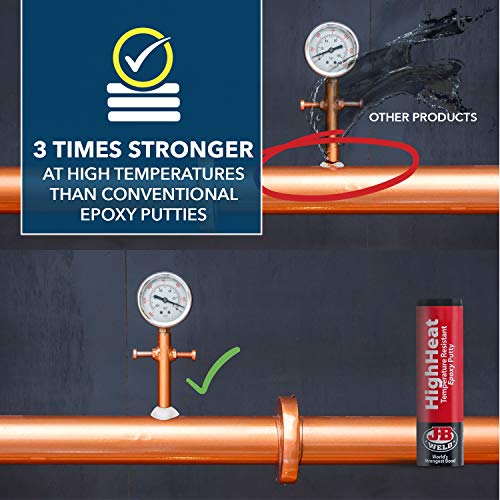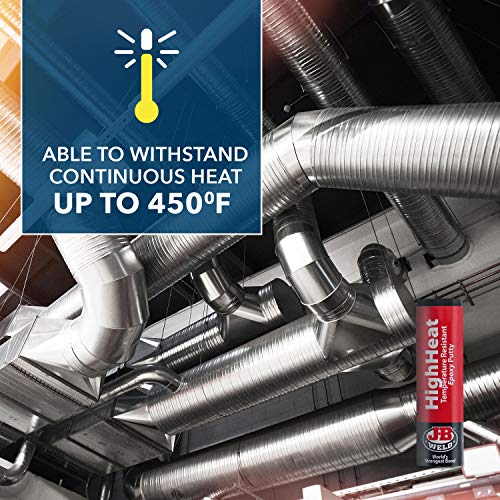- HIGHHEAT: Is a hand mixable epoxy putty stick specifically formulated to bond and repair materials that will be exposed to high temperatures in automotive and industrial maintenance applications.
- THE ORIGINAL COLD WELD: JB Weld was developed as an alternative to torch welding. Designed to be effective in extreme environments, once it sets, it creates a permanent bond stronger than steel.
- EASY TO USE: This industrial-strength product outperforms conventional epoxy putties at high temps and sets in 1 hour. After 8 hours, it can be drilled, tapped, machined, ground, filed and painted.
- VERSATILE & DEPENDABLE: Perfect for exhaust manifolds, mufflers, engine blocks, duct work & more. Tensile strength of 800 PSI. It is able to withstand heat exposure of 400ºF and intermittent to 550ºF.
- DO IT YOURSELF: Big or small, you can DIY it with J-B. Our heavy duty adhesives repair & restore it right the first time. JB Weld delivers the legendary performance of the World's Strongest Bond.
- 3 times stronger at high temperatures
- Withstands continuous heat up to 450 degrees Fahrenheit, and intermittent heat up to 500 degrees Fahrenheit
- Strength of 800 PSI at room temperature and 600 PSI at 400 degrees Fahrenheit
- Perfect for tail pipes, mufflers, machinery, engine blocks, and exhaust manifolds
- Special Shipping Information: This item cannot be returned and has additional shipping restrictions
-
Information
-
Twitter
-
Pinterest
-
Youtube
-
Facebook






Jessie Besson
Awesome product! I fixed exhaust pipe on my 26 ...
Awesome product! I fixed exhaust pipe on my 26 old Honda Accord with no problems in 10 minutes. Very easy to use and when its cured its hard as rock! Good job J-B Weld!
Jessica Canhigh
Did the job
My tailpipe disconnected from my muffler and it made my impreza sound like a Harley. The garage I took it to before welded it back on and only lasted a month or two. Instead of taking it back there I decided to give this stuff a try. I got two ribs and molded it around the tailpipe where it connects to the muffler and let it cure overnight. The next day I started the car up and no noise was coming out of it. It's been about 2 weeks since and it is still holding up even with a frigid winter here. Definitely would recommend.
Jess Alderwood
This stuff is great!
I've used this stuff on a number of projects and so far, have been impressed with the results. It insulates electrically and can handle a lot of heat. Two good characteristics of a material. Forming things is quite easy and once it sets (about 4-6 hours), can be sanded like any epoxy. After 24 hours, it becomes super hard and much tougher to work with so if you need to smooth it out, do so right after it sets instead of waiting. I suggest wearing rubber gloves when working with this material.
Daniela Garcia
Proper prep work on a broken in half exhaust pipe ...
Proper prep work on a broken in half exhaust pipe has led this product to holding the pipe together without any signs of breaking. - Sanded and grinded both sides where the epoxy was going to touch -cleaned with degreaser and then isopropyl alcohol Seemed to be all it took to grab hold of the metal.
Marsha Felton
Worked on a Car Radiator (for 3 1/2 months)
I used this to patch a 15mm open crevice in my car's brass radiator. I cleaned the surface 1cm from the crack on all sides with a wire brush and sandpaper. I mixed the epoxy by repeatedly flattening it and folding the edges into the center. It's very sticky so it helps to slide your finger off the edge of the patch rather than pulling it away which can pull the epoxy loose. It didn't seem like it would work, but I was able to easily clean the uncured epoxy from my fingers with soap and water and a bit of rubbing with a paper towel. I let it cure for 3 days before driving the car. It reaches 1/4 strength in 8hrs and full strength in 3 days. I've driven the car at highway speeds for 30min twice now and no water is leaking. If the patch fails, I'll update this review. This was posted 5/26/2017. Update: The radiator patch failed and began leaking again after 3 1/2 months. Oh, well. It was worth a try.
Maani Khan
Good product to fix Muffler.
Around the exhaust pipe on the muffler itself was rusted all around it and would waddle. Bought this and it worked well with covering the rust and keeping the pipe in place. It is like a giant was of gum you can use to press into cracks or holes in a pipe or muffler. Read that mufflers/exhaust pipes can get hot between 300-600 degrees. This stuff is perfect for this. For some odd reason, at first, it was not sticking to the muffler. After more and more needing and pressing it, it finally stayed adhered. The tubes are only 2 oz. So I would suggest to at least two packages of this opoxy. It's tough stuff so a little challenging applying it. Gotta take your time and be patient with it. For best results, apply this to area and don't use car for 15-24 hours best for it to become strong and cured. So far so good for over a week after applying it and doing highway driving. Good fix for $14 vs. $600 for a new muffler.
Lauren Gilliam
Figured out where problems occur with this.... It's all user error.
So I ordered two of these to fix a hole in my exhaust before the muffler by a clamp. So I applied a small amount of the putty without cleaning or anything... Let it cure, and by let it cure I just went to work for a few days and the burning smell stopped. This worked for a couple weeks. Okay, this was all my fault. So this time I tried a bit harder to make this work properly. I took the whole tube and rolled it in my hands until it was the light gray color it's supposed to be. I wiped off all the loose rust, but didn't sand anything to bare metal. I had a small dish of water as this helps keep it from sticking to your hands, makes it much easier to work with. Wrapped it around the pipe and kept pushing it into the surface and spreading it. Essentially spread it until its hard to move and doesn't seem like it will come off. This has worked for months. Heard an exhaust leak the other day and thought the putty failed. Nope, it was a new leak on the hangar and the spot I fixed was still solid. This is an old car that's going to be traded in a few months, hence me not replacing that section of exhaust...
Gary Jimenez
Works Great: Follow these instructions
Have used multiple times for application to highest heat conditions motor vehicles produce. It's a very strong and permanent repair if you follow these instructions: 1. Area must be clean from rust and grease. Clean the grease off first with any good solvent. Clean the rust off with a wire wheel attached to a drill. The metal must be shiny clean. 2. (optional) Roughen area with a mini-grinder with cut off wheel. 3. Cut off adequate amount of epoxy. Using your bare hands rub between hands like you are trying to roll a snake shape. Fold it back against itself and roll another snake. Do this over and over again for two minutes. 4. Pinch a small portion off and smear it onto the surface. Press hard and smear. Pull it off and smear more onto the surface. Eventually it will adhere and not pull off. do this for the entire area you want to adhere the epoxy. This should take no longer than about a minute. 5. Finally, apply the remainder of the epoxy onto the area, Press and then pull the edges inward, then press again. Do this until the edges don't pull away. Clean hands with any good hand cleaner and scrub brush. Let dry overnight.
Amber Hawkins
I used this to plug a hole in the manifold ...
I used this to plug a hole in the manifold of my Toyota Pickup. Three weeks later the plug is still in place doing it's job. I've seen negative reviews on here and would suggest it's impatience that caused the issues. First, you must completely mix the two ingredients together and second you must allow plenty of time for the application to cure. I allowed over night. Fired it up the next morning and went on a 200 mile trip with no failure... then or since.
Zilan P Nhene
Good for hard-to-glue items
I've used this for several kitchen repair jobs, including a plastic whisk, a spoonula, and pot handle that is subject to a lot of heat. The putty is a little tricky to apply -- and you'd better get it into the shape you want it, because it dries hard as a rock -- but it seems to make a good bond. I've learned to be more fastidious about shaping it properly while it's pliable, but it can be adjusted later with sandpaper or a nail file.